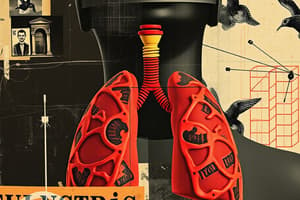Podcast
Questions and Answers
What is a primary source of carbon monoxide (CO) in aviation?
What is a primary source of carbon monoxide (CO) in aviation?
- Exhaust fumes from piston-engine aircraft (correct)
- Navigation instruments
- Air conditioning units
- Unburnt fuel in engines
How does carbon monoxide (CO) affect hemoglobin in the blood?
How does carbon monoxide (CO) affect hemoglobin in the blood?
- It binds with hemoglobin over 200 times more readily than oxygen (correct)
- It causes hemoglobin to become unstable
- It enhances the ability to carry oxygen
- It converts hemoglobin into another molecule
Which of the following is NOT a common symptom of carbon monoxide poisoning?
Which of the following is NOT a common symptom of carbon monoxide poisoning?
- Disorientation
- Weakness
- Fatigue
- Increased appetite (correct)
What amplifies the effects of carbon monoxide poisoning in the cockpit?
What amplifies the effects of carbon monoxide poisoning in the cockpit?
What immediate action should be taken if carbon monoxide exposure is suspected?
What immediate action should be taken if carbon monoxide exposure is suspected?
What is a significant consequence of even minor carbon monoxide poisoning in pilots?
What is a significant consequence of even minor carbon monoxide poisoning in pilots?
What characteristic of carbon monoxide makes it particularly dangerous?
What characteristic of carbon monoxide makes it particularly dangerous?
Which factor does NOT contribute to the production of carbon monoxide in aviation?
Which factor does NOT contribute to the production of carbon monoxide in aviation?
What is the primary risk of reduced oxygen levels at altitude in relation to CO poisoning?
What is the primary risk of reduced oxygen levels at altitude in relation to CO poisoning?
Which action should be taken first if CO poisoning is suspected during a flight?
Which action should be taken first if CO poisoning is suspected during a flight?
What is the role of CO detectors in aircraft?
What is the role of CO detectors in aircraft?
Which of the following is NOT a preventive measure against CO exposure?
Which of the following is NOT a preventive measure against CO exposure?
Why is it critical to recognize and respond to CO poisoning during flight?
Why is it critical to recognize and respond to CO poisoning during flight?
Which maintenance practice is recommended to reduce CO exposure risk?
Which maintenance practice is recommended to reduce CO exposure risk?
What upcoming topic does the course promise to address next?
What upcoming topic does the course promise to address next?
What is a potential consequence of ignoring CO exposure in flight?
What is a potential consequence of ignoring CO exposure in flight?
What is the maximum quantity of dry ice allowed on each flight without accessible cargo areas?
What is the maximum quantity of dry ice allowed on each flight without accessible cargo areas?
Which of the following is NOT a critical element of handling dry ice safely on flights?
Which of the following is NOT a critical element of handling dry ice safely on flights?
In the event of carbon dioxide overexposure, what is one of the immediate steps that should be taken?
In the event of carbon dioxide overexposure, what is one of the immediate steps that should be taken?
What is the primary reason for the FAA's restrictions on dry ice quantity during air transport?
What is the primary reason for the FAA's restrictions on dry ice quantity during air transport?
What kind of situations does the discussion of vestibular illusions relate to?
What kind of situations does the discussion of vestibular illusions relate to?
What is the primary role of dry ice in aviation cargo transportation?
What is the primary role of dry ice in aviation cargo transportation?
What should crew members recognize concerning dry ice risks?
What should crew members recognize concerning dry ice risks?
What significant risk does dry ice present when transported in an aircraft?
What significant risk does dry ice present when transported in an aircraft?
At what temperature does dry ice exist as a solid?
At what temperature does dry ice exist as a solid?
What is the primary purpose of packaging and labeling dry ice correctly during transport?
What is the primary purpose of packaging and labeling dry ice correctly during transport?
How is dry ice categorized by aviation authorities?
How is dry ice categorized by aviation authorities?
Why is the crew's vigilance emphasized in the safety protocols for transporting dry ice?
Why is the crew's vigilance emphasized in the safety protocols for transporting dry ice?
What is a critical step that must be taken when packaging dry ice?
What is a critical step that must be taken when packaging dry ice?
What symptoms might indicate elevated carbon dioxide levels due to dry ice exposure?
What symptoms might indicate elevated carbon dioxide levels due to dry ice exposure?
Which property of dry ice makes its sublimation unpredictable in pressurized environments?
Which property of dry ice makes its sublimation unpredictable in pressurized environments?
What should pilots and crew specifically be trained to recognize regarding dry ice transport?
What should pilots and crew specifically be trained to recognize regarding dry ice transport?
What physiological effect does carbon monoxide have on the blood?
What physiological effect does carbon monoxide have on the blood?
Which of the following symptoms is least likely associated with carbon monoxide poisoning?
Which of the following symptoms is least likely associated with carbon monoxide poisoning?
What is the potential risk of using dry ice in an aircraft's confined space?
What is the potential risk of using dry ice in an aircraft's confined space?
What preventive measure is recommended for pilots to combat the risks of carbon monoxide?
What preventive measure is recommended for pilots to combat the risks of carbon monoxide?
Which scenario would most likely lead to carbon monoxide poisoning in aviation?
Which scenario would most likely lead to carbon monoxide poisoning in aviation?
Which group of individuals is most at risk of carbon monoxide poisoning during flights?
Which group of individuals is most at risk of carbon monoxide poisoning during flights?
How does the Federal Aviation Administration (FAA) mitigate the risks associated with dry ice transport?
How does the Federal Aviation Administration (FAA) mitigate the risks associated with dry ice transport?
Which symptom should pilots be particularly vigilant about when using cabin heat?
Which symptom should pilots be particularly vigilant about when using cabin heat?
Flashcards are hidden until you start studying
Study Notes
Carbon Monoxide (CO) Poisoning in Aviation
- Carbon monoxide is a colorless, odorless gas produced by incomplete combustion of carbon-containing materials.
- Major aviation sources of CO include exhaust fumes from piston-engine aircraft, ground equipment, and malfunctioning cabin heaters.
- CO binds to hemoglobin in the blood approximately 240 times more readily than oxygen, forming carboxyhemoglobin, which decreases oxygen transportation to tissues.
- Common symptoms of CO poisoning include headache, fatigue, dizziness, weakness, nausea, and disorientation; severe cases can lead to confusion, collapse, or death.
- The aircraft environment amplifies CO effects due to high altitudes and enclosed spaces, leading to faster onset and increased severity of symptoms.
- Immediate actions in case of suspected CO poisoning include turning off heat, increasing ventilation, using supplemental oxygen if available, and landing at the nearest suitable airport.
- CO detectors are essential in aircraft for early warning of hazardous exposure to carbon monoxide.
- Preventive measures include regular maintenance of exhaust systems, pre-flight inspections, avoiding idling engines near air intakes, and periodic venting of the cabin.
Dry Ice (Solid Carbon Dioxide) in Aviation
- Dry ice is a solid form of carbon dioxide, essential for transporting temperature-sensitive goods as it sublimates without creating liquid mess.
- The surface temperature of dry ice is -78.5 °C (-109.3 °F); as it sublimates, it can drastically increase CO2 levels in enclosed cabin environments at altitude.
- Dry ice is classified as a Class 9 hazardous material due to its potential to displace oxygen, posing risk to passengers and crew in case of leaks or spills.
- Signs of elevated CO2 levels to be vigilant for include dizziness, headache, and shortness of breath.
- Proper packaging and labeling of dry ice are mandated, with vented packages required to prevent explosive pressure from gas buildup.
- The FAA limits the amount of dry ice permitted on flights to no more than 5.5 pounds per passenger on aircraft without accessible cargo areas.
- Regular checks of dry ice storage areas, familiarity with carbon dioxide detectors, and knowledge of emergency response procedures are critical for crew safety.
- In cases of overexposure to CO2 from dry ice, actions include increasing cabin ventilation, providing supplemental oxygen, and potentially diverting the flight.
Summary and Future Lessons
- Recognizing and responding to CO poisoning is critical for flight safety; vigilance against this silent threat is vital.
- Safe handling of dry ice is crucial due to its hazardous classification, with understanding its properties and risks being fundamental for pilots.
- Next lesson will focus on spatial orientation and vision systems, including effects of vestibular illusions such as ‘the leans’ and ‘graveyard spiral’.
Studying That Suits You
Use AI to generate personalized quizzes and flashcards to suit your learning preferences.




